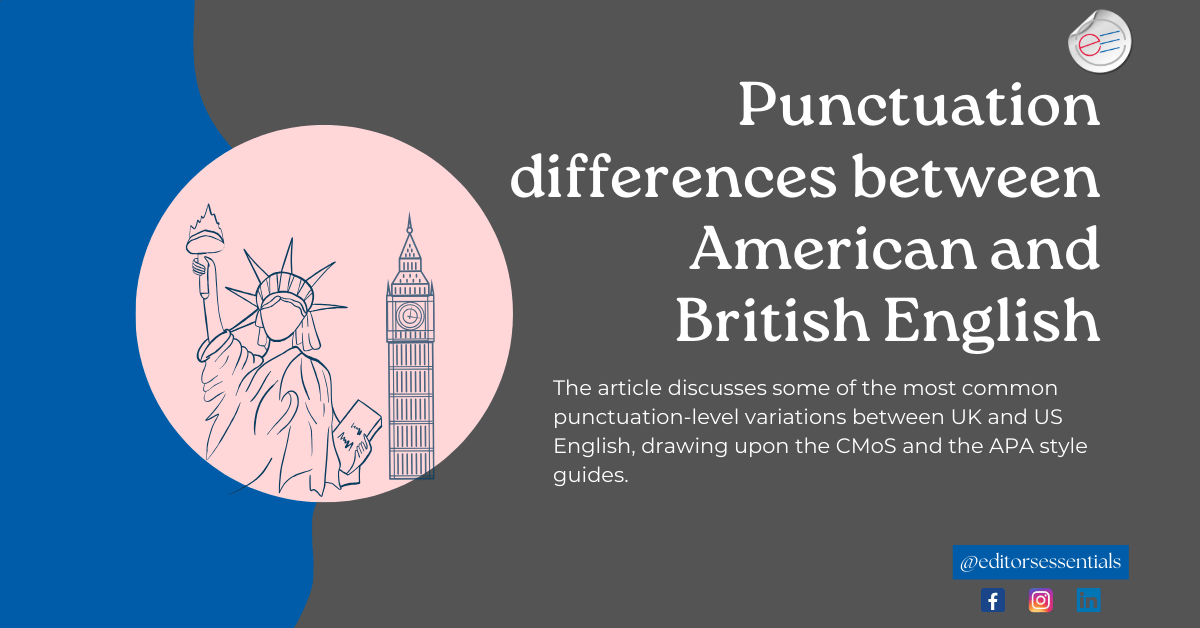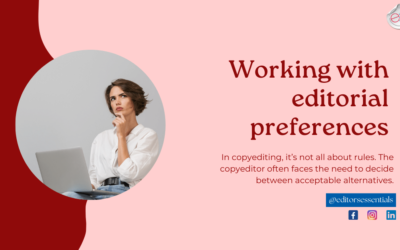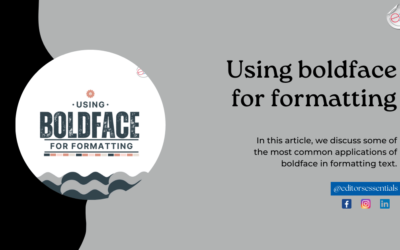Table of contents
- Introduction
- The serial comma
- Quotation marks and the placement of periods and commas
- Date format
- Parenthetical dashes
- The abbreviations e.g. and i.e.
- Final thoughts
We all know that English originated in England and later spread to the regions colonized by the British Empire. However, after several decades of the decolonization of the British Empire, English still remains the official language of many countries it once colonized and the unofficial mode of communication in several countries. Hence, it is given the name “universal language”.
Variations in the English language can be broadly categorized into two aspects: variations in spoken English and variations in written English. The former deal with differences in pronunciations of words and region-specific terms that the global audience is unaware of, whereas the latter include variations in spelling, punctuation, formatting dates, and other aspects of written English. This blog post discusses English variations that are acceptable in academic publishing and focuses on the latter.
The two major English variants followed in academic publishing are British English (UK English) and American English (US English), though there are other variants that closely follow the conventions of these two with very few deviations, such as Australian English and Canadian English.
Some of the frequently discussed topics among UK/US English variants include the following:
- spelling variations of Greek terms, such as realise vs realize and analyse vs analyze;
- spelling variations of Latin terms, such as colour vs color and centre vs center; and
- consonant doubling, such as labelled vs labeled and modelling vs modeling.
These are primary elements to be considered when deciding the English variant to be followed or while ensuring a specific English variant is followed consistently in a manuscript. Besides these differences, some terms take an entirely different form in the two variations; for example, lift and aeroplane in the UK are denoted as elevator and airplane in the US, respectively.
However, there are other aspects as well that fall under the scope of variations in written English. This blog post presents some of the major differences in punctuation between UK and US English. Even before we start discussing them, I have a disclosure to declare: these are not hard-and-fast rules like the colour vs color variation, but conventions. While making any editorial decisions based on these conventions, the copyeditor should have a thorough understanding of the publisher’s requirements and the author’s preferences.
Let’s start this post with a brief discussion on the serial comma.
The serial comma
You know that one of the major uses of commas is to separate items in a list. The last item is usually preceded by a conjunction and a comma is used between other items. Consider this example:
The four C’s of copyediting are correctness, consistency, coherence and clarity.
The above sentence has a four-item list connected by the conjunction and. Optionally, we may add a comma before the conjunction, called the serial comma (aka the Oxford comma, named after the preference of the Oxford University Press to use it). This means that the sentence can also be written as:
The four C’s of copyediting are correctness, consistency, coherence, and clarity.
In general, using the serial comma is widely encouraged while following US English, whereas – ironically – it is less appreciated in UK English.
However, the serial comma is preferred in cases where its omission causes ambiguity. Consider this example:
This book is dedicated to my brothers, Jimmy and Howard.
One may think that Jimmy and Howard are actually the brothers the author refers to, with “Jimmy and Howard” acting as appositives to the noun brothers. However, if Jimmy and Howard are not the brothers, there is a high chance that the reader may misunderstand this sentence without a comma. In such cases, the serial comma comes in handy:
This book is dedicated to my brothers, Jimmy, and Howard.
Quotation marks and the placement of periods and commas
Quotation marks can be used in a sentence for two reasons: (i) to indicate a direct speech or an excerpt from previous publications and (ii) to emphasize a word or a sentence fragment.
Alexander Graham Bell told Watson, “Mr. Watson, come here – I want to see you” over the phone.
The term “egg corn” was coined by professor of linguistics Geoffrey Pullum.
The first sentence is an example of using quotation marks to denote a direct speech, and the second one is an example of using quotation marks to add emphasis.
In general, double quotation marks are preferred while following the US style, whereas single quotation marks are preferred while following the UK style. Furthermore, there is another distinction that takes into account the placement of end periods and commas with respect to the closing quotation mark.
In UK English, periods and commas are placed after the closing quotation mark unless they belong to the quoted text itself.
John said, ‘I don’t know this will happen’.
John said, ‘I don’t know this will happen’, which surprised everyone in the room.
In both these examples, the end period and the comma are placed outside the closing quotation mark as they are not part of the quoted text.
In US English, periods and commas are placed before the closing quotation mark, regardless of whether they were in the original text.
John said, “I don’t know this will happen.”
John said, “I don’t know this will happen,” which surprised everyone in the room.
However, there may be cases where, besides knowing these conventions, a further understanding of the context is required. Consider this sentence:
John asked, ‘What should I do now?’
The question mark here belongs to the quoted text and should be placed before the closing quotation mark regardless of the English variant followed, because the actual sentence here is a statement and cannot end with a question mark. Moreover, since there is a question mark at the end of the sentence, which itself is an end punctuation mark, there is no need to add a period to denote the sentence ending.
Date format
The difference in formatting of dates involves the arrangement of day, month and year and the (non)use of commas. In UK English, the date–month–year format is preferred, whereas in US English, the month–date–year format is preferred. Consider these examples:
The president flew to London on 1 December 2023 in a private jet. (UK style)
The president flew to London on December 1, 2023, in a private jet. (US style)
Notice also the use of commas in the US style. A comma is used to separate the date and the year, both of which are numerals, to avoid potential ambiguity. To show that the sentence continues after the year, another comma is used, thus enclosing the year within a pair of commas.
This pair of commas is not required while following the UK style as the date and the year are separated by the month, which is usually written in words, thus avoiding the above-mentioned confusion.
Of course, the need for commas arises only when all three parts of the date are present and does not hold if either the year or the date is missing:
I visited New York in March 2023. (UK/US English)
The meeting is postponed to 21 December. (UK English)
The meeting is postponed to December 21 US English. (US English)
Parenthetical dashes
A parenthetical element is a word or word group that adds additional (nonessential) information to a sentence and, in most cases, interrupts the flow of the sentence (like the phrase enclosed with commas in this sentence).
For better readability, a parenthetical element needs to be set off from a sentence using either commas or dashes. A dash looks like a hyphen, but is longer.
Two types of dashes are used in written English: en dashes and em dashes. The en dash is named so as it occupies the same space required for inserting the letter N in a word processor. Now you know why the em dash is named so. For a better understanding, let’s keep it this way: the hyphen (-) is the shortest of all, the em dash (—) is the longest, and the en dash (–) sits in between.
In MS Word, you can insert these dashes via the “Symbol” option in the “Insert” tab or by using the keyboard shortcuts shown below.
Although both dashes can be used to set off a parenthetical element from a sentence (similar to a pair of commas), en dashes are preferred in UK English and em dashes in US English.
The captain – though not yet recovered from the shock of the unexpected defeat – congratulated his counterpart. (UK style)
The captain—though not yet recovered from the shock of the unexpected defeat—congratulated his counterpart. (US style)
Note the use of word spaces on either side of the parenthetical en dashes in the UK style; em dashes are almost always closed up with the adjacent words, however.
Apart from being used as parenthetical dashes, en dashes are also used to denote numerical ranges, e.g. the phrase page 1–10 refers to starting from page 1 up to page 10.
The abbreviations i.e. and e.g.
The abbreviation i.e. stands for the Latin phrase id est, which can be translated to that is in English, and the abbreviation e.g. stands for the Latin phrase exempli gratia, which can be translated to for example.
Note the usage of periods with these abbreviations, and they are followed by a comma in US English, but not in UK English:
I need something refreshing, e.g. a cup of coffee. (UK English)
I need something refreshing, e.g., a cup of coffee. (US English)
However, these abbreviations are always preceded by a comma when they appear within a sentence.
Final thoughts
As I mentioned earlier, the topics we discussed so far are just conventions that are in general followed by many authors and publishers. These are not stringent rules like colour vs color variations.
For instance, some publishers may prefer UK English, but recommend the use of the serial comma, and vice versa. On the contrary, some publishers may insist on following, for example, US English with respect to spelling, but accept the author’s usage with respect to these punctuation-level variations provided consistency is ensured. In that case, a copyeditor should understand the author’s preference and adhere to the same while ensuring consistent usage throughout the manuscript.
When requirements such as these are explicitly mentioned in the style sheet, you can apply them in the manuscript straight away without the need for much reasoning. However, if there are no instructions about how to deal with such issues, it is always recommended that you get them clarified by the publisher or the author.
Did you find this post insightful? Have you come across any similar issues that I missed to include in this post? Kindly share your thoughts in the comments section.





0 Comments